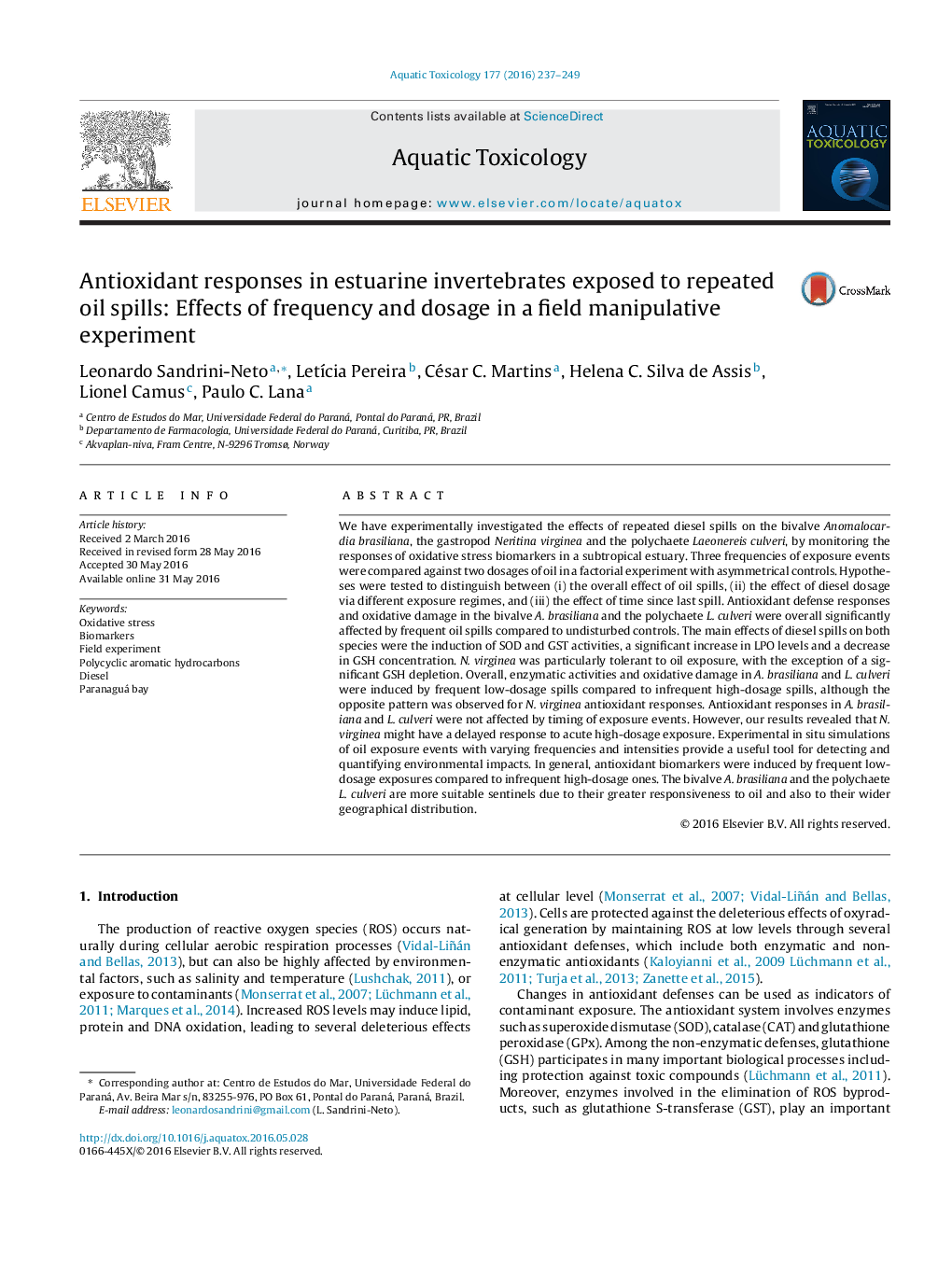| کد مقاله | کد نشریه | سال انتشار | مقاله انگلیسی | نسخه تمام متن |
|---|---|---|---|---|
| 6382012 | 1625928 | 2016 | 13 صفحه PDF | دانلود رایگان |
عنوان انگلیسی مقاله ISI
Antioxidant responses in estuarine invertebrates exposed to repeated oil spills: Effects of frequency and dosage in a field manipulative experiment
ترجمه فارسی عنوان
پاسخ های آنتی اکسیدانی در بی مهرگان دریای استوایی در معرض تلرانس نفتی مکرر: تاثیر فرکانس و دوز در یک آزمایش دستکاری
دانلود مقاله + سفارش ترجمه
دانلود مقاله ISI انگلیسی
رایگان برای ایرانیان
کلمات کلیدی
استرس اکسیداتیو، بیومارکرها، آزمایش میدانی، هیدروکربن های آروماتیک چند حلقه، دیزل، پارانوگا بایر،
موضوعات مرتبط
علوم زیستی و بیوفناوری
علوم کشاورزی و بیولوژیک
علوم آبزیان
چکیده انگلیسی
We have experimentally investigated the effects of repeated diesel spills on the bivalve Anomalocardia brasiliana, the gastropod Neritina virginea and the polychaete Laeonereis culveri, by monitoring the responses of oxidative stress biomarkers in a subtropical estuary. Three frequencies of exposure events were compared against two dosages of oil in a factorial experiment with asymmetrical controls. Hypotheses were tested to distinguish between (i) the overall effect of oil spills, (ii) the effect of diesel dosage via different exposure regimes, and (iii) the effect of time since last spill. Antioxidant defense responses and oxidative damage in the bivalve A. brasiliana and the polychaete L. culveri were overall significantly affected by frequent oil spills compared to undisturbed controls. The main effects of diesel spills on both species were the induction of SOD and GST activities, a significant increase in LPO levels and a decrease in GSH concentration. N. virginea was particularly tolerant to oil exposure, with the exception of a significant GSH depletion. Overall, enzymatic activities and oxidative damage in A. brasiliana and L. culveri were induced by frequent low-dosage spills compared to infrequent high-dosage spills, although the opposite pattern was observed for N. virginea antioxidant responses. Antioxidant responses in A. brasiliana and L. culveri were not affected by timing of exposure events. However, our results revealed that N. virginea might have a delayed response to acute high-dosage exposure. Experimental in situ simulations of oil exposure events with varying frequencies and intensities provide a useful tool for detecting and quantifying environmental impacts. In general, antioxidant biomarkers were induced by frequent low-dosage exposures compared to infrequent high-dosage ones. The bivalve A. brasiliana and the polychaete L. culveri are more suitable sentinels due to their greater responsiveness to oil and also to their wider geographical distribution.
ناشر
Database: Elsevier - ScienceDirect (ساینس دایرکت)
Journal: Aquatic Toxicology - Volume 177, August 2016, Pages 237-249
Journal: Aquatic Toxicology - Volume 177, August 2016, Pages 237-249
نویسندگان
Leonardo Sandrini-Neto, LetÃcia Pereira, César C. Martins, Helena C. Silva de Assis, Lionel Camus, Paulo C. Lana,
